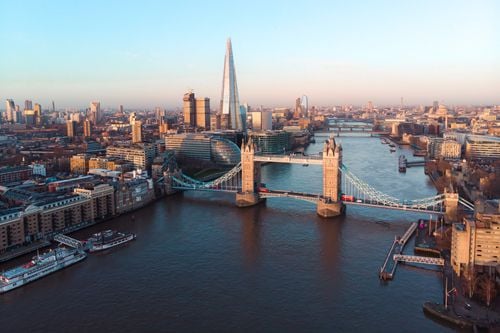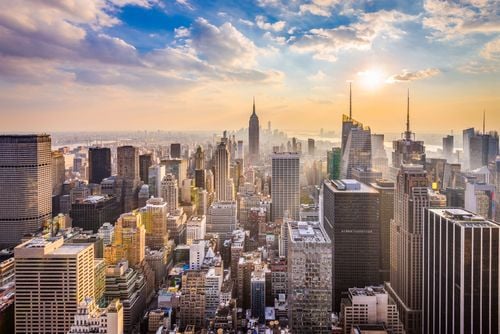Human settlements are known to have existed at Ancoats since at least 1212, with the name likely deriving from the Old English ana coats, meaning “lonely cottages”. For most its life a sparse hamlet of Northern English cottages and farmland, the creeping onset of the Industrial Revolution in Britain in the nineteenth century and the transformation of Manchester into Britain’s ‘Cottonopolis’ saw Ancoats unrecognisably transformed into an area known as the “Cradle of the Industrial Revolution”, already home to at least sixteen mills by the start of the nineteenth-century, when the construction of the Rochdale Canal only brought more industry and bodies to the area. So, by 1815, Ancoats was the most populous district in Manchester and had gained a reputation as the “world’s first industrial suburb”, albeit one rampant with issues of overcrowding, crime, and illness.
Regularly voted one of the coolest neighbourhoods in the world by cultural watchdog magazine Time Out, it feels like a new concept bar or small-plate restaurant pops up every other week in vibrant Ancoats, an underdog area now wrestling with neighbouring Northern Quarter for the Mancunian hipster-favourite crown. Located along the Rochdale Canal, a former Industrial-Revolution artery that bisects the bustling city, Ancoats was little more than an eye-sore urban slum for most of the twentieth century before an astounding regeneration drive in the 1990s saw dilapidated mills transformed into plush flats and independent theatres and stagnant streets repopulated with chic crafts store, bohemian bakeries, and the city’s only Michelin-starred restaurant. Once synonymous with decline and squalor, Ancoats is now one of the most exciting urban enclaves in the UK (and Manchester’s gastronomical heart!).
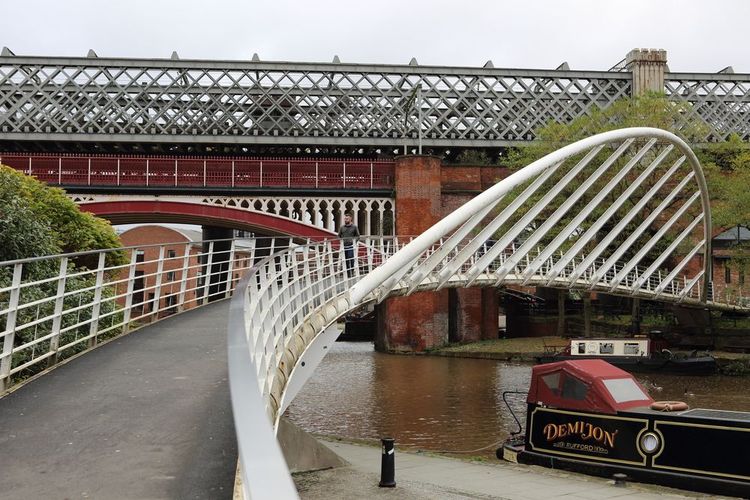
A sculptural bridge over the Rochdale Canal in Ancoats, Manchester.
- © Eugene Regis / ShutterstockHistory
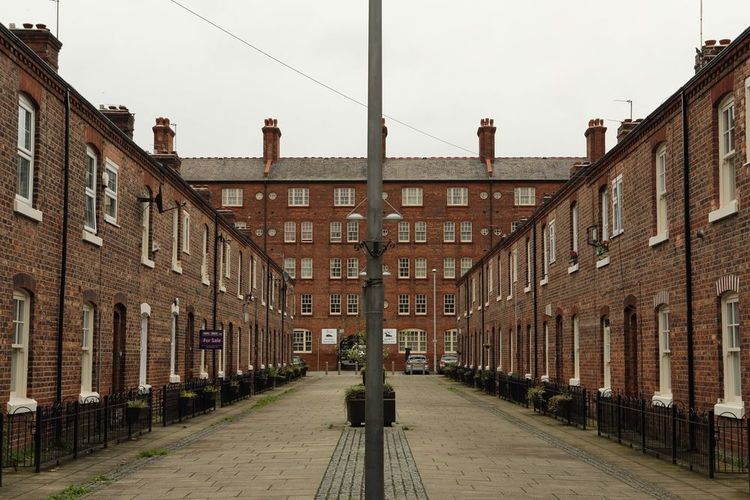
A cul-de-sac of terraced houses characteristic of historic Ancoats, Manchester.
- © Eugene Regis / ShutterstockFun Fact!
By 1815, the neighbourhood of Ancoats had a population of almost 54,000 people, more than nearby cities like Bury and Blackburn!

The construction of the Rochdale Canal through Manchester in the early nineteenth century brought unprecedented levels of industry to the city.
- © trabantos / ShutterstockWhen the cotton industry stalled in the 1930s, Ancoats swiftly spiralled into further social deprivation as the colossal mills that dominated its urban landscapes were abandoned and people moved out of the once-packed terraced houses so iconic of the district. It was only in the 1990s that interest in the area was revived as Manchester City Council underwent a huge effort to bring new investment and regeneration into the decayed canal-side location and, although by 1998 an estimated 80 per cent of business space in Ancoats still lay vacant, a second wave of private regeneration bids in the early 2000s set the transformation of the former industrial slum into since-unstoppable motion, most significantly courtesy of the New Islington Project whose 31-acre plot of land to the south of Ancoats, now known as New Islington Marina, became (and still stands as) an indispensable wellspring of redevelopment and innovative new business in the area.
Ancoats Today
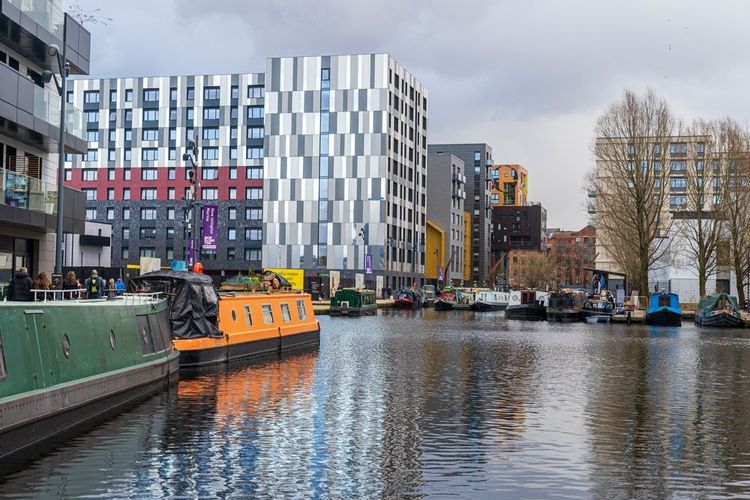
Ancoats is a neighbourhood where old meets new in Manchester.
- © Dragon Claws / ShutterstockAncoat’s today is one of England’s and Europe’s trendiest neighbourhoods, locked in bitter rivalry with nextdoor Northern Quarter for the title of Manchester’s most desirable district. Architecturally speaking, it is a patchwork of past and present, the shells of Victorian mills and warehouses - since repurposed to house boutique stores, arts spaces, and chic eateries - rubbing shoulders with sleek contemporary housing blocks along the old canals that were once the economic lifeblood of the district and city more broadly. Cutting Room Square epitomises this feel, an open-air hub in the heart of Ancoats where imported cotton was once cut (hence the name) but now flanked by converted buildings resplendent with terrasse restaurants and watched over carefully by St. Peter’s Church. The church, dating to 1858, is a repurposed space too, now known as Hallé St. Peters, the home of the 165-year-old Hallé Choir and Symphonic Orchestra, who occasionally perform small concerts in the unique space.
https://www.youtube.com/watch?v=Z10HZFynEbg
From Ancoats, follow the canals and cobbled roads east to New Islington Marina, a secluded waterside paradise in the heart of the city. The wide marina waters are dotted with doting swans and a spunky kaleidoscope of technicolour canal barges, while on sunny days its open green spaces become packed with dog walkers and sunbathes in blissful urban idyll.
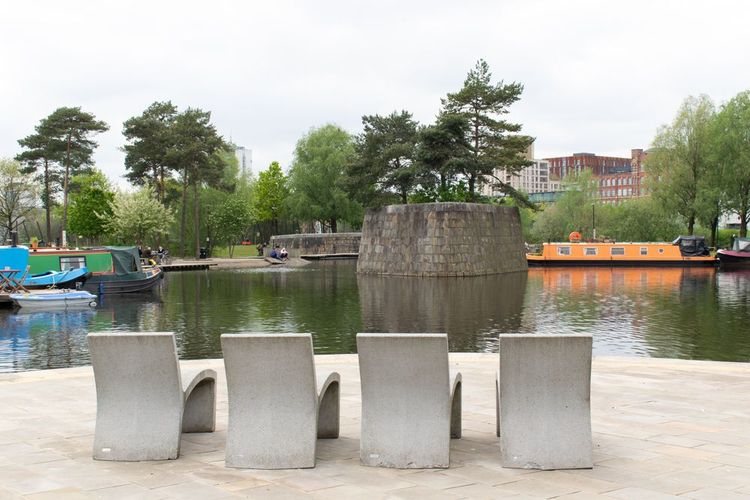
New Islington Marina with a view of Cotton Fields Park across the water.
- © John B Hewitt / ShutterstockA Taste of Manchester’s Gastronomical Capital
However, if there’s one thing to do when passing through Ancoats and New Islington, it’s to try the food that has made the neighbourhood famous. Mana made news when it became the first restaurant in Manchester to receive a Michelin star in forty-two years back in 2018, an honour it has fiercely retained every year since under the stewardship of head chef (and Manchester local) Simon Martin. Reservation-only, the stylish eatery - where every table has full view of the kitchen - draws on Martin’s culinary odysseys through Japan and Scandinavia while using the best of local, British produce to curate an avant-garde, ‘minimal to the eye, maximal on the tongue’ menu. Be warned, Mana comes maximum on the wallet too though! Reserving one of the restaurant’s 9 tables can take months in advance and costs in excess of £150 for the petite (but masterfully crafted) tasting menu.
For some heartier flavours at less lofty prices, we can recommend several spots in Ancoats. Rudy’s is an homage to Ancoats’ historic Italian community that have earned the neighbourhood a reputation as Manchester’s ‘Little Italy’, selling pizzas on an award-winning Neapolitan sourdough base for as little as £5. Pollen Bakery is another local favourite, its rustic homemade sourdough breads and mouthwatering viennoiseries regularly attracting snaking queues outside its otherwise humble doors.
Meanwhile, on Great Ancoats Street you’ll find a totally unique experience at CHA-OLOGY, a Japanese teahouse where owner Mei enacts an exclusive sensory ritual that turns tea-tasting into an artform. To preserve the sanctity of the experience, a strict set of rules is upheld: guests must arrive promptly, strong perfumes cannot be worn to preserve the gentle aromas cultivated in harmony with the menu, and the website warns in advance: “please refrain from visiting if the main purpose is photography or chatting.”
Practical Information
Ancoats is easy to find in Manchester, being just a twelve-minute walk from the city’s main bus and tram terminus in Piccadilly Gardens. It is also regularly serviced by various direct bus and tram lines - for more information visit the Transport for Greater Manchester website here.



